|
Size: 579
Comment:
|
Size: 12282
Comment:
|
| Deletions are marked like this. | Additions are marked like this. |
| Line 7: | Line 7: |
| Several display modes are available for recordings. They are all accessible with a right-click. | Several display modes are available for recordings. They are all accessible with a right-click.The first three menus (MEG, Stimulation input, Video Time), represent all the different types of channels that were found in the channel file. You can check that with Channel Edit (right-click on channel file > Edit). |
| Line 9: | Line 9: |
| {{attachment:treePopupRecordings.gif}} | {{attachment:treePopupRecordings.gif||height="291px",width="401px"}} <<BR>>Now repeat this operation several times to display all the available modes: ''Display time series, 3D sensor cap, 2D sensor cap, 2D disc'' and ''2D Layout''. You should now see all the following figures. Keep them opened for the next few paragraphs, we will learn how to manipulate multiple views of the same data. * '''Display time series''': values over the time for all the sensors<<BR>>Zoom with mouse wheel, move with left+right or middle mouse click+move<<BR>><<BR>> {{attachment:dataTimeSeries.gif}} * '''3D sensor cap, ''''''2D sensor cap, 2D disc''': The recordings at a given time instant and interpolated over a 2D or 3D surface <<BR>>2D figures: Zoom with mouse wheel, move with left+right or middle mouse click+move<<BR>>3D figures: regular mouse operations as introduced in previous tutorials. <<BR>><<BR>> {{attachment:data3Dcap.gif}} {{attachment:data2Dcap.gif}} {{attachment:data2Ddisc.gif}} * '''2D layout''': The time course of each channel is drown at the actual position of the electrode, projected in 2D the same way as ''2D sensor ''<<BR>>Zoom with mouse wheel, move with left-click+move. ''cap'' <<BR>><<BR>> {{attachment:data2Dlayout.gif}} |
| Line 12: | Line 19: |
| The time window and the current time instant are centralized and managed by the ''Time window'' panel in Brainstorm window. You can use the text boxes and the slider to set the time bounds or to change the current time value. All the figures always stay synchronized, you cannot display the 2D disc topography at t=10ms and the 3D sensor cap topography at t=50ms at once. It might look too strict at the beginning, but the contrary would have made the interface much too complex; we wanted to keep it as simple as possible. {{attachment:timeWindow.gif}} The time is not the best way to browse your data. There are many other shortcuts that are much more intuitive to navigate through the time. * '''Click on ''''''time series'''''' figure''':<<BR>>Left-click in any white area of the figure and it will move the time cursor at this point, and update all the other figure to match this new value. Don't click on a black line, it would select the corresponding channel instead of moving the time cursor. * '''Press the keyboard arrows''': <<BR>>Click on any data figure and try to press several time the left and right arrows, and also the ''!PageUp ''and ''!PageDown ''keys. This feature is really useful when you want to quickly see how the recordings are changing in the time. It might be a bit slow because you have many figures to refresh at each time change. It should be much faster if you have only one topography window. To remember: An efficient and quick way to review your recordings just after importation is to: 1. Open a Time series window (double click on recordings file) 1. Click on the time of interest (eg. first response peak) 1. Open a topography view of your choice (2D disc, 2D sensor cap, or 3D sensor cap)<<BR>>You can do this by right-clicking on the time series figure > MEG Topography (or Ctrl+T keyboard shortcut). 1. Use the left/right arrows, and !PageUp/PageDown keys |
|
| Line 13: | Line 36: |
| You can select some channels, and then display them separately or mark them as good or bad. 1. Now close all the figures except the ''Time series'' and the ''2D Sensor cap'' topography (if you don't remember which one it was, close everything and open again these two figures following the 4 steps in previous section). 1. On 2D Disc figure: right-click anywhere on the window ''> Channels > Display sensors''. You'll see white dots representing the center of each MEG coil. Note that there is keyboard shortcut indicated for this menu: ''Ctrl + E''. 1. Press'' Ctrl + E'' several times and see what happens. Come back to the display with only the sensors markers (no labels). 1. Click on some white dots. * They turn red and the corresponding lines in the time series window also turn red. * Left-click on the lines in the time series window: it also selects the sensors. * Right-click on a red line in time series figure: you'll have the name and indice of the selected channel. * Click on a selected (red) point or line: the sensor is deselected. * To deselect all the sensors at once, press ''Escape ''key, or ''right-click > Channels > Reset selection'' 1. Now select three sensors.<<BR>><<BR>> {{attachment:channelSelection.gif}} 1. Right-click > Channels > View selected (Shortcut = enter). A new window is created, with only those three sensors, whose names are indicated in a legend box (you can move this legend if needed).<<BR>><<BR>> {{attachment:channelPopupMenu.gif}} {{attachment:channelViewSelected.gif}} == Good / bad channels == If you find out that a sensor has unexpected values, that are not coherent with the other surrounding sensors, you can choose to ignore it in the displays and in the source estimation process. In the channel file, each channel has a flag which indicates if is good or bad. You may also import recordings files that already have some bad channels defined. * '''Mark channels as bad''':<<BR>>You should still have three sensors selected in both figures. Right-click > ''Channels > Set selected as bad'', or press ''Delete ''key. The sensors should disappear in all figures, and the topography view (2D sensors cap) is updated so that the interpolation now ignores the bad channels.<<BR>><<BR>> {{attachment:channelSetBad.gif}} * '''Get the channels back''': two options * Right-click on figure > ''Channels > Mark all channels as good<<BR>>'' * Right-click on figure ''> Channels > Edit good/bad channels...'' : this menu open a window very similar to the Channel Editor window introduced in previous tutorials, but without the annoying location and orientation values, and with green and red dots. Click on the dots to mark a channel as good or bad. <<BR>><<BR>>''' {{attachment:channelEditGoodBad.gif}} ''' * Note that if you click on a row in this window, it will select the corresponding channel in the time series and topography figures. * Close this window to save the changes. * '''Batching this from the database explorer''': * You will find a "Channels" menu you right-click on any node in the tree that contains recordings. * If you select on the of the item in this menu, the operation will be applied recursively to all the recordings contained in the node. This way, you can quickly set that the channel 63 is always bad, or that electrode 43 is not working for subject #12, without having to visualize all the recordings one after the other. * The'' View all bad channels'' command displays the list of all the bad channels in all the files in the ''Messages ''tab, in main Brainstorm window. <<BR>><<BR>> {{attachment:channelTreePopup.gif||height="309px",width="376px"}} * '''Important notes''': * The good/bad channel flags are stored in the recordings files, not in the channel files. So if you marked some channels as ''bad ''in the ''ERP ''data file, there are still considered as ''good ''in the ''Std ''data file. |
|
| Line 14: | Line 70: |
| We will now describe how to manipulated the colormap in the topography windows. Open a ''2D sensor cap'' view, and play with colors. * Brainstorm keeps track of four user-defined colormaps: Anatomy, Recordings, Sources and Stat. You can go to the Colormaps menu in the Brainstorm main window to see this list. Usually, you will use only popup menus on figures to edit the colormaps. * If you modify a colormap, the changes will be saved in your user preferences and available the next time you start Brainstorm. * For the moment, you are going to play only with Recordings colormap, but the other work exactly the same way. * Right-click on you ''2D sensor cap'' figure > Colormap.<<BR>><<BR>> {{attachment:colormapPopup.gif}} * '''Colormap''': You can change the colors that are used to represent the recorded MEG values. You can create your own colormaps with the Matlab colormap editor, clicking on the last option ''Custom''. * '''Absolute values''': Displays the absolute values of the recordings, instead of the original values. This is the default for ''Anatomy, Sources'' and ''Stat ''colormaps, but it is not very useful for recordings: for for EEG and MEG, the sign of the values is very important. * '''Normalized for each time frame''': * If not selected: The bounds of the colormap are set to the maximum value across the whole time window. Eg. if you use the ''rbw'' colormap and the min and max values are [-80ft, +130ft], the colors will be mapped in the following way: -130ft is blue, +130ft is red, 0ft is white. And it will be like this wherever, for each time sample. * If selected: It uses the local min and max values at the current time frame, instead of the global min and max. Eg. at t=0ms, the extrema values are roughly [-17ft, +17ft]. So the colors will be mapped in order to have: -17ft = blue, and +17 = red.<<BR>>If you uncheck this option and go to t=0ms, the 2D topography figure will turn almost white. * You can usually keep this ''Normalized ''option when looking at recordings, it makes things nicer. But keep in mind that it is not because you see flashy colors that you have a strong effects. It's always a matter of colormap configuration. * '''Set colorbar max value''': disable when ''Normalized ''option is selected, because it wouldn't have any effect. This menu allows you to fix the maximum bounds of the colormap, instead of using the automatic ones. * Click on it, it will ask you for the maximum value you want. * Set it first to 5, then do it again and then to 500; and observe that it modifies the values displayed on the right side of the color bar, in the ''2D sensor cap'' figure. * Select one last time this menu, and follow the instruction to reset it: enter 0. It will go back again to the automatic bounds. * Remember that when you use this option, it is saved in your user preferences, so it can cause some trouble: You close Brainstorm, you start it again one week later, you totally forget that you had set this value to a very high level, you try to import and review new recordings, all you see is white, you spend two hours to understand why, you install a new version of Brainstorm and it stays desperately white... Just think about checking this option. * '''Contrast and Brightness''': * Brightness moves the center of the colormap up and down. * Contrast saturate/desaturate the colors. * The words brightness/contrast may not be adapted for colormaps such as ''rbw, jet'' or ''hsv;'' but try selecting the ''grey ''colormap, it suddenly makes more sense. * On some combinations of Matlab version / operating systems, those sliders may not work (it depends on the embedded Java virtual machine version). * You can also modify those values by clicking directly on the color bar in the figures. Hold the mouse button, and move up/down to change the brightness and left/right to change the contrast. Even if the sliders do not work, you can modify the colormaps. * '''Display colorbar''': Just in case you want to hide the color bar... * '''Restore defaults''': Click on it '''now '''so all your experimentations will be discarded. == Manipulate multiple windows == == Keyboard shortcuts == Here is a memo with all the keyboard shortcuts of time series and topography figures. If you don't remember them, you can find many of them in the figure popup menus. |
Tutorial: Explore the recordings
This tutorial is based on the TutorialCTF protocol, and will show you how to explore efficiently the sensory response to an electric stimulation of the fingers. The two previous tutorials explain how to create this tutorial and describe the data that are used in it.
Contents
Display modes
Several display modes are available for recordings. They are all accessible with a right-click.The first three menus (MEG, Stimulation input, Video Time), represent all the different types of channels that were found in the channel file. You can check that with Channel Edit (right-click on channel file > Edit).
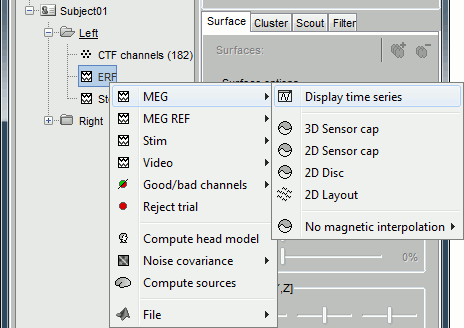
Now repeat this operation several times to display all the available modes: Display time series, 3D sensor cap, 2D sensor cap, 2D disc and 2D Layout. You should now see all the following figures. Keep them opened for the next few paragraphs, we will learn how to manipulate multiple views of the same data.
Display time series: values over the time for all the sensors
Zoom with mouse wheel, move with left+right or middle mouse click+move
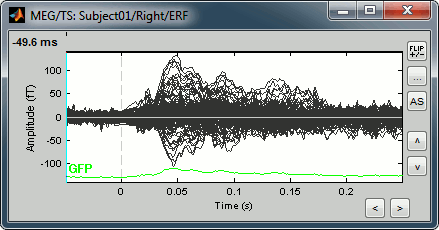
3D sensor cap, 2D sensor cap, 2D disc: The recordings at a given time instant and interpolated over a 2D or 3D surface
2D figures: Zoom with mouse wheel, move with left+right or middle mouse click+move
3D figures: regular mouse operations as introduced in previous tutorials.
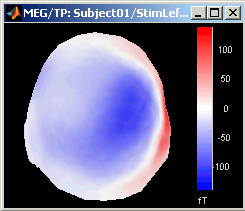
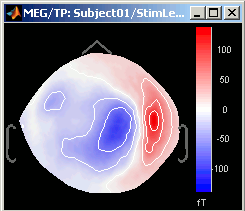
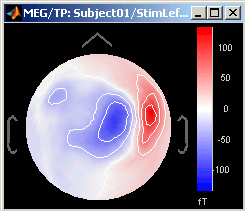
2D layout: The time course of each channel is drown at the actual position of the electrode, projected in 2D the same way as 2D sensor
Zoom with mouse wheel, move with left-click+move. cap
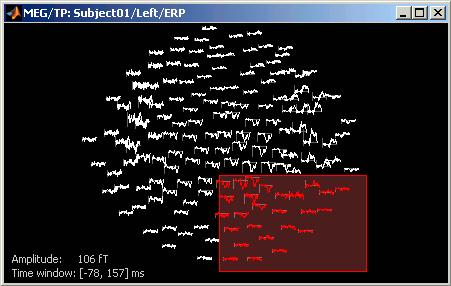
Time exploration
The time window and the current time instant are centralized and managed by the Time window panel in Brainstorm window. You can use the text boxes and the slider to set the time bounds or to change the current time value. All the figures always stay synchronized, you cannot display the 2D disc topography at t=10ms and the 3D sensor cap topography at t=50ms at once. It might look too strict at the beginning, but the contrary would have made the interface much too complex; we wanted to keep it as simple as possible.

The time is not the best way to browse your data. There are many other shortcuts that are much more intuitive to navigate through the time.
Click on time series figure:
Left-click in any white area of the figure and it will move the time cursor at this point, and update all the other figure to match this new value. Don't click on a black line, it would select the corresponding channel instead of moving the time cursor.Press the keyboard arrows:
Click on any data figure and try to press several time the left and right arrows, and also the PageUp and PageDown keys. This feature is really useful when you want to quickly see how the recordings are changing in the time. It might be a bit slow because you have many figures to refresh at each time change. It should be much faster if you have only one topography window.
To remember: An efficient and quick way to review your recordings just after importation is to:
- Open a Time series window (double click on recordings file)
- Click on the time of interest (eg. first response peak)
Open a topography view of your choice (2D disc, 2D sensor cap, or 3D sensor cap)
You can do this by right-clicking on the time series figure > MEG Topography (or Ctrl+T keyboard shortcut).Use the left/right arrows, and PageUp/PageDown keys
Sensors selection
You can select some channels, and then display them separately or mark them as good or bad.
Now close all the figures except the Time series and the 2D Sensor cap topography (if you don't remember which one it was, close everything and open again these two figures following the 4 steps in previous section).
On 2D Disc figure: right-click anywhere on the window > Channels > Display sensors. You'll see white dots representing the center of each MEG coil. Note that there is keyboard shortcut indicated for this menu: Ctrl + E.
Press Ctrl + E several times and see what happens. Come back to the display with only the sensors markers (no labels).
- Click on some white dots.
- They turn red and the corresponding lines in the time series window also turn red.
- Left-click on the lines in the time series window: it also selects the sensors.
- Right-click on a red line in time series figure: you'll have the name and indice of the selected channel.
- Click on a selected (red) point or line: the sensor is deselected.
To deselect all the sensors at once, press Escape key, or right-click > Channels > Reset selection
Now select three sensors.

Right-click > Channels > View selected (Shortcut = enter). A new window is created, with only those three sensors, whose names are indicated in a legend box (you can move this legend if needed).
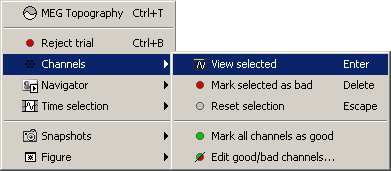
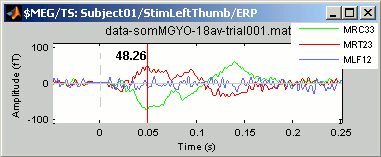
Good / bad channels
If you find out that a sensor has unexpected values, that are not coherent with the other surrounding sensors, you can choose to ignore it in the displays and in the source estimation process. In the channel file, each channel has a flag which indicates if is good or bad. You may also import recordings files that already have some bad channels defined.
Mark channels as bad:
You should still have three sensors selected in both figures. Right-click > Channels > Set selected as bad, or press Delete key. The sensors should disappear in all figures, and the topography view (2D sensors cap) is updated so that the interpolation now ignores the bad channels.

Get the channels back: two options
Right-click on figure > Channels > Mark all channels as good
Right-click on figure > Channels > Edit good/bad channels... : this menu open a window very similar to the Channel Editor window introduced in previous tutorials, but without the annoying location and orientation values, and with green and red dots. Click on the dots to mark a channel as good or bad.

- Note that if you click on a row in this window, it will select the corresponding channel in the time series and topography figures.
- Close this window to save the changes.
Batching this from the database explorer:
- You will find a "Channels" menu you right-click on any node in the tree that contains recordings.
- If you select on the of the item in this menu, the operation will be applied recursively to all the recordings contained in the node. This way, you can quickly set that the channel 63 is always bad, or that electrode 43 is not working for subject #12, without having to visualize all the recordings one after the other.
The View all bad channels command displays the list of all the bad channels in all the files in the Messages tab, in main Brainstorm window.
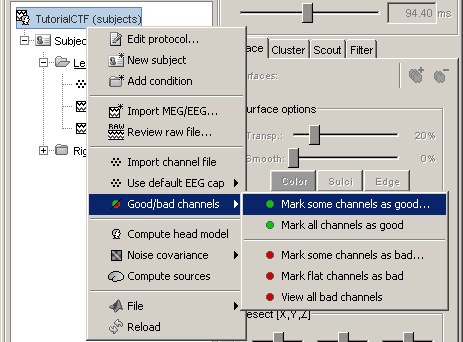
Important notes:
The good/bad channel flags are stored in the recordings files, not in the channel files. So if you marked some channels as bad in the ERP data file, there are still considered as good in the Std data file.
Colormap configuration
We will now describe how to manipulated the colormap in the topography windows. Open a 2D sensor cap view, and play with colors.
- Brainstorm keeps track of four user-defined colormaps: Anatomy, Recordings, Sources and Stat. You can go to the Colormaps menu in the Brainstorm main window to see this list. Usually, you will use only popup menus on figures to edit the colormaps.
- If you modify a colormap, the changes will be saved in your user preferences and available the next time you start Brainstorm.
- For the moment, you are going to play only with Recordings colormap, but the other work exactly the same way.
Right-click on you 2D sensor cap figure > Colormap.
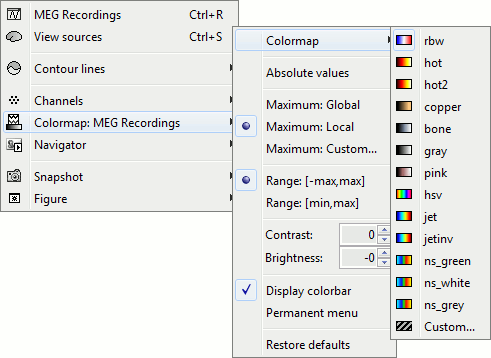
Colormap: You can change the colors that are used to represent the recorded MEG values. You can create your own colormaps with the Matlab colormap editor, clicking on the last option Custom.
Absolute values: Displays the absolute values of the recordings, instead of the original values. This is the default for Anatomy, Sources and Stat colormaps, but it is not very useful for recordings: for for EEG and MEG, the sign of the values is very important.
Normalized for each time frame:
If not selected: The bounds of the colormap are set to the maximum value across the whole time window. Eg. if you use the rbw colormap and the min and max values are [-80ft, +130ft], the colors will be mapped in the following way: -130ft is blue, +130ft is red, 0ft is white. And it will be like this wherever, for each time sample.
If selected: It uses the local min and max values at the current time frame, instead of the global min and max. Eg. at t=0ms, the extrema values are roughly [-17ft, +17ft]. So the colors will be mapped in order to have: -17ft = blue, and +17 = red.
If you uncheck this option and go to t=0ms, the 2D topography figure will turn almost white.You can usually keep this Normalized option when looking at recordings, it makes things nicer. But keep in mind that it is not because you see flashy colors that you have a strong effects. It's always a matter of colormap configuration.
Set colorbar max value: disable when Normalized option is selected, because it wouldn't have any effect. This menu allows you to fix the maximum bounds of the colormap, instead of using the automatic ones.
- Click on it, it will ask you for the maximum value you want.
Set it first to 5, then do it again and then to 500; and observe that it modifies the values displayed on the right side of the color bar, in the 2D sensor cap figure.
- Select one last time this menu, and follow the instruction to reset it: enter 0. It will go back again to the automatic bounds.
- Remember that when you use this option, it is saved in your user preferences, so it can cause some trouble: You close Brainstorm, you start it again one week later, you totally forget that you had set this value to a very high level, you try to import and review new recordings, all you see is white, you spend two hours to understand why, you install a new version of Brainstorm and it stays desperately white... Just think about checking this option.
Contrast and Brightness:
- Brightness moves the center of the colormap up and down.
- Contrast saturate/desaturate the colors.
The words brightness/contrast may not be adapted for colormaps such as rbw, jet or hsv; but try selecting the grey colormap, it suddenly makes more sense.
- On some combinations of Matlab version / operating systems, those sliders may not work (it depends on the embedded Java virtual machine version).
- You can also modify those values by clicking directly on the color bar in the figures. Hold the mouse button, and move up/down to change the brightness and left/right to change the contrast. Even if the sliders do not work, you can modify the colormaps.
Display colorbar: Just in case you want to hide the color bar...
Restore defaults: Click on it now so all your experimentations will be discarded.
Manipulate multiple windows
Keyboard shortcuts
Here is a memo with all the keyboard shortcuts of time series and topography figures. If you don't remember them, you can find many of them in the figure popup menus.
